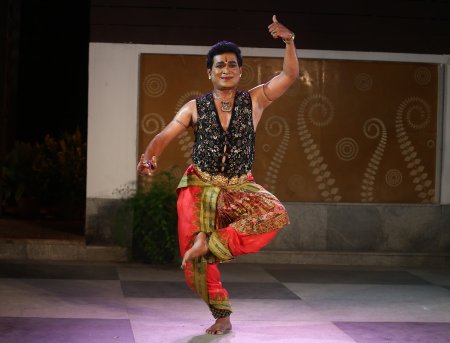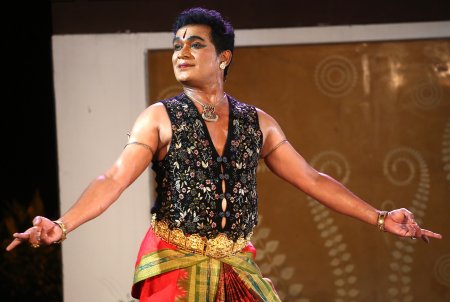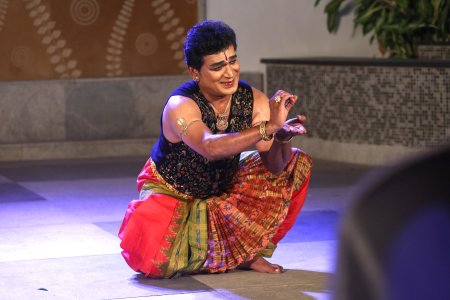
|   |

|   |
Vazhuvoor Sampradaya by Shanmuga Sundaram - Jeetendra Hirschfeld e-mail: sathirdance@gmail.com Photos: Chella Videos March 15, 2024 On Sunday evening of March 3rd, Shanmuga Sundaram presented 'Vazhuvoor Sampradaya' at Narthaki Studio, Chennai, featuring five original choreographies by the renowned nattuvanars Vazhuvoor Ramaiah Pillai and K.J. Sarasa. The Narthaki Studio Series, produced by Dr. Anita Ratnam, showcases a variety of performances, including dance, stand-up comedy, rap poetry, storytelling, and instrumental music. Anita Ratnam initiated the studio series as a platform for artistes to showcase their artistry and creativity, particularly those less represented in mainstream festivals. The series aims to facilitate direct interaction between artistes and spectators, allowing the artistes to explore performances they might not typically present at formal festivals. Having followed Shanmugam since around 2000, I have often attended his performances. Besides the Margam repertoire, he has choreographed several thematic performances. Recently, for the past year or so, Shanmugam has been working with a group of enthusiastic transgender students. His commitment goes beyond merely imparting dance skills; he aims to empower his transgender students and actively integrate diverse aesthetics into Bharatanatyam art through his teaching. Since the passing of K.J. Sarasa (in 2012), Shanmugam has remained faithful to his roots, paying homage to his guru through his annual festival 'Sarasa Natya Mala'. Since 2017, Shanmugam has been a mentee of the eminent guru Chitra Visweswaran, whose mentorship, in my opinion, has brought focus, conviction, and artistic nuance to his art, guiding him to explore new dimensions of expression and refine his technique. I arrived 30 minutes before the start of the performance, driven by my lifelong fear of arriving late. Narthaki Studio's manager L. Subashri, an artiste in her own right who has assisted Anita Ratnam for many years, warmly welcomed me. The rarefied ambience of the outdoor performance space, harmonising seamlessly with the serenity of the garden, provided an exquisite backdrop for an enchanting evening of Bharatanatyam. With the final light and sound check by the much sought-after Victor Paulraj, the musical ensemble took their places. The ensemble featured nattuvangam by Sukanya Ravindhar, who also provided introductions to the dances, vocals by Preethi Mahesh, mridangam by Ramana, and veena by Mudikondan Ramesh. The opening, "Vaarana mukha vaa" (Hamsadhwani), composed by Koteeshvara Iyer, was one of K.J. Sarasa's favourite items. She adapted this invocation about twenty years ago. The composer's invocation states, "The elephant-faced one, please come and guide me!" The sloka, "Vaakkundaam nalla manamundaam" (Avvaiyar), preceded the song. The second dance of the evening was "Manduka sabda", a composition by Melattur Kasinatha from the 18th century. This sabdam, famously a part of the Kuchipudi repertoire, underwent adaptation for Bharatanatyam choreography by Vazhuvoor Ramaiah nattuvanar (in Kambhoji, Suruti, Gowla) and gained popularity through his iconic disciple, Kumari Kamala. Shanmugam learned this dance from K.J. Sarasa. The padartha of the sabdam narrates the story of Gajendra Moksham, depicting how Lord Vishnu saved the elephant Gajendra from a crocodile. The salient feature of the sabdam is the marvellous sollukattu sequences, where the poet vividly captures the sound of the battle in the lotus pond where Gajendra finds himself ensnared. According to Shanmugam, legend has it that since there was no one to witness Gajendra moksha, the frogs who observed it later spoke of its glory.  In "Kancha dalayatakshi Kamakshi" (Kamala Manohari), Muthuswami Dikshitar praises the goddess: "Kamakshi, the one who has large lotus-like eyes, Oh Kamala Manohari! You are Tripura Sundari!" Shanmugam's performance stood out for the distinctive Devi poses characteristic of the Vazhuvoor style. "Natanam adinar" is an energising dance celebrating Lord Shiva in Chidambaram, balancing creation and destruction. This once-popular dance in the second half of the Margam has more or less disappeared despite being a timeless classic. A composition in Vasanta by Gopalakrishna Bharatiyar, Shanmugam danced to the choreography of Vazhuvoor Ramaiah Pillai. The high point was the exciting variations of the Sarukkal adavu in the Vazhuvoor style, executed with mesmerising grace, an arched back, and a stretched-out leg in muzhumandi. Sukanya Ravindhar's mastery as the orchestra conductor particularly shone through in her nattuvangam performance for the khanda ata talam.  The performance concluded with the famous "Baaro Krishnayya" (ragamalika) by Kanaka Dasa. K.J. Sarasa, a close friend of the iconic singer M.L. Vasanthakumari, a great fan of her music, adapted numerous songs sung by MLV into her Bharatanatyam repertoire. The beautiful virutham "Baliya manege vamana bandante" prefaced the song. In the lyrics, the poet invites Lord Krishna to the devotee's house, expressing his devotion and seeking protection. Shanmugam beautifully expressed the poetry, particularly the sensitive portrayal of the moment when the priests denied Kanaka Dasa entry into the temple at Udupi. He depicted Kanaka's futile attempts to gain access as he circumambulates the temple. Finally, the idol of Krishna turned towards Kanaka, granting him the opportunity to witness the lord in all his beauty and splendour. The portrayal of the temple and Kanaka's struggle to enter appeared seamless as the dancer performed in the garden. The electrifying vocals of Preethi Mahesh provided the perfect accompaniment. With this Devaranama, the evening came to an end.  The rendition of five dances, originally choreographed years ago, retains a timeless freshness. Preserving the artistic vision of the nattuvanar masters is crucial for future generation dancers. Shanmugam presented each dance unhurried and executed complete adavus for both the right and left sides, something we see less often. His abhinaya does not necessarily explicitly state the emotion but subtly suggests it through nuanced expressions and movements. The dancer can convey them convincingly to the audience, evoking an emotional response and creating a compelling connection between the performer and the viewer. As the Chennai summer heat rapidly approaches, the Narthaki Studio Series takes a brief hiatus. However, stay tuned for an exciting lineup of performances that promise to inspire and enchant audiences.  Jeetendra Hirschfeld is a Bharatanatyam artiste, writer, and researcher in dance history with special interests in Tanjore Natyam Art, Courtesans, and Royals. |